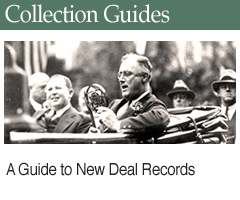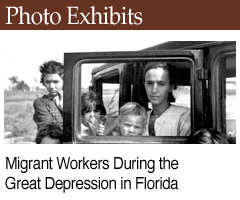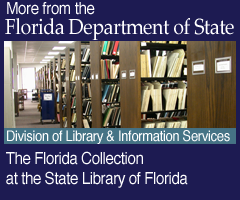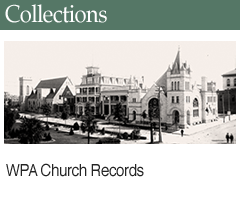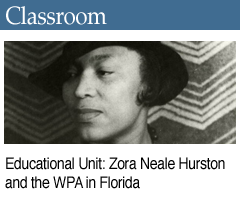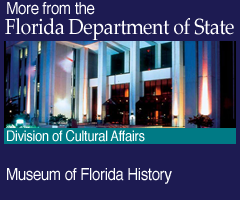WPA Stories
About the Collection
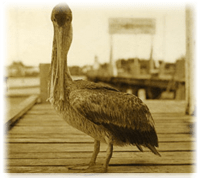
The stories presented here were created by writers working for the Federal Writers' Project of the Works Project Administration (WPA) in Florida. These writings present a variety of subject matter, from folk stories and nature writings to scientific research and Florida history, in mostly short pieces intended for use in Florida classrooms.
The Federal Writers' Project was created in 1935 in an effort to find work suitable for the nation's thousands of unemployed writers, historians, librarians, and teachers. Part of Federal One, the name given to the four arts programs of the WPA (along with Theater, Music and Art), the Writer's Project became both a lightning rod for criticism of President Franklin D. Roosevelt's New Deal programs and an ambitious attempt to harness the nation's idle writing and research talents to document America's cultural and social history.
Directed by Henry J. Alsberg, and enjoying the support of prominent Washington figures such as First Lady Eleanor Roosevelt, the Federal Writers' project achieved its goals by employing thousands of America's professional and unknown writers and producing a robust cultural record of the nation. However, the program was fated to be a victim of political divisions and the nation's shifting priorities as concerns about the lingering Great Depression gave way to preparations for the looming Second World War.
By the outbreak of war, opposition to the project by congressional conservatives, who accused the WPA of supporting writers with communist sympathies, and the Roosevelt administration's increasing emphasis on defense spending, led to the end of the project. After 1939, the project existed under state sponsorship and became known as the WPA Writer's Program. It is during that period, as the Writers' Program wound to a close, that the Florida program created these pieces for classrooms.
“Notwithstanding the dismaying confusion that attended nearly everything we did, we had a sense of being part of a significant historical event.
In a literal sense, we were making history, for nothing like the Writers' Project or the other three federal arts projects had ever been tried by any nation anywhere.”
The Federal Writers' Project became the most expansive piece of collective research ever conducted by any nation on itself. Writers visited every rural corner, small town, and crossroads in the country, leaving future generations a massive documentation of their own nation unlike any the world has ever seen, before or since.
After just four years, the project had produced 320 publications, including 100 full-length books, with more than 600 other books in some stage of production.
Some writers were envious of their colleagues working for the Federal Art Project since at least they were able to paint creative subjects. National director Alsberg made the case to members of congress, as well as writers working for the project, that non-fiction writing was as just significant as creative writing and that much of the best writing in the world at the time was coming from economists and sociologists, not novelists and poets.
Harry Hopkins, national director of all the WPA programs, famously responded to the constant criticisms of the New Deal policies that paid artists and writers by saying, "Hell, they've got to eat just like other people."
Although the research included in these essays was undoubtedly incorporated into publications from the Florida Writers Project such as the Florida guidebook, this collection, originally intended for use in classrooms, has never before been published.
History of the Florida Writer's Project
Carita Doggett Corse was Florida's state director for the Florida Writer's Project for its duration, from 1935 until 1942. Corse personally interviewed and hired every writer working for the project in Florida and was one of the few state directors to last the entire tenure. Many of the publications that emerged from the Florida project were sponsored by the Department of Agriculture. Corse was also one of the first directors to recognize the importance of folk history. Along with Stetson Kennedy, she traveled around the state recording songs and conducting interviews with former slaves. Zora Neal Hurston was the best known writer to contribute to the black section of the writer's project in Florida. Photographers working with the project documented the folklife and everyday work of Depression-era Florida.
Including historical research, composites of field interviews, folklore, and travel log, these pieces add more color and detail to the invaluable portrait of Florida before World War II provided by the better-known WPA works and the countless efforts influenced and inspired by them. In the writings of the Florida project, the need for creative expression is apparent, as is the care and attention to language that writers brought to what some may have considered mundane work.
During the early years of World War II, project writers made pamphlets for the Jacksonville and Pensacola air stations. Under Corse's direction, the Florida writers produced one of the most highly praised of the state guide books which remain the most visible lasting contribution of the state programs.
By the time of the completion of the Florida Guide, Corse was well aware of the political scrutiny the project was undergoing. She was able, in part by sending two staff members with the guide to Washington, to keep it from being too mutilated and censored by Washington editors. Florida and Director Corse avoided the political controversy that dogged many of the Writers Program in other states. Although having fewer established writers to draw from, Florida also had fewer political radicals. As a result, Florida produced a large amount of high quality work with only minor controversies such as Catholic criticism of the female director and wartime objections to the presence of ethnic Germans on the program's staff.
The national staff of the Writers Project never exceeded 6,680 people, 90 percent of who were required to be hired from welfare rolls. Although many of those hired in Florida and other states were inexperienced, many possessed remarkable talents and energy for the work they undertook. The project helped hone these attributes into professional skills, inspiring many staff members to pursue careers in academia or as writers.
Of the nearly 2,000 published works of the Federal Writers' Project, more than 90 of them were created by Florida writers.
Works Cited
Federal Writers' Project of the Works Progress Administration for the State of Florida. Florida: A Guide to the Southernmost State. American Guide Series. New York: Oxford University Press, 1939.
Mangione, Jerry. The Dream and the Deal: the Federal Writers Project, 1935-1943. Boston: Little, Brown & Company, 1972.
Powell-Brant, Evanell K. "WPA Writers' Project, with Emphasis on The Florida Writers and Carita Doggett Corse." Lake Panasoffkee, FL: Evanell K. Powell-Brant, 1990.
State of Florida Department of Public Instruction. The WPA Guide to Florida: the Federal Writers' Project Guide to 1930s Florida. Introduction by John I. McCollum. New York: Pantheon Books, 1984.

 Listen: The Blues Program
Listen: The Blues Program